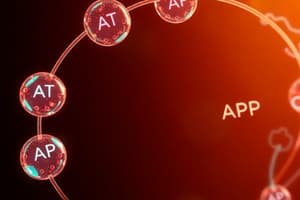Podcast
Questions and Answers
Which type of metabolite is directly involved in essential physiological processes necessary for life?
Which type of metabolite is directly involved in essential physiological processes necessary for life?
- Secondary Metabolites
- Provisional Metabolites
- Primary Metabolites (correct)
- Dynamic Metabolites
What characterizes anabolic (biosynthetic) pathways in metabolism?
What characterizes anabolic (biosynthetic) pathways in metabolism?
- They utilize energy to form complex molecules from simpler ones. (correct)
- They occur only during catabolic reactions.
- They release energy.
- They involve complex structures breaking down into simpler forms.
What type of bond is formed by the removal of CO2 from an amino acid to produce an amine?
What type of bond is formed by the removal of CO2 from an amino acid to produce an amine?
- Peptide Bond
- Ester Bond
- Amine Bond (correct)
- Glycosidic Bond
Which statement best describes catabolic pathways?
Which statement best describes catabolic pathways?
How can the flow of metabolites through metabolic pathways be compared to automobile traffic?
How can the flow of metabolites through metabolic pathways be compared to automobile traffic?
What is the role of adenosine triphosphate (ATP) in living systems?
What is the role of adenosine triphosphate (ATP) in living systems?
Which statement about enzymes is true?
Which statement about enzymes is true?
What are the chemicals on which enzymes act called?
What are the chemicals on which enzymes act called?
Which is the fastest enzyme known, accelerating its reaction significantly?
Which is the fastest enzyme known, accelerating its reaction significantly?
In a multistep metabolic pathway, what is true about the enzymes involved?
In a multistep metabolic pathway, what is true about the enzymes involved?
Flashcards are hidden until you start studying
Study Notes
Chemical Reactions in Cells
- Nutrients essential for cell metabolism include carbohydrates (glycosidic bonds), proteins (peptide bonds), and lipids (ester bonds).
- Key reactions involve the removal of CO2 from amino acids to form amines and the hydrolysis of glycosidic bonds.
Metabolites
- Primary Metabolites: Necessary for life; include amino acids, nucleic acids, sugars, lipids, and vitamins.
- Secondary Metabolites: Not essential for growth but may provide benefits; examples are essential oils, toxins, and drugs.
Metabolic Pathways
- Metabolic pathways function like traffic flows in a city, with a defined rate and direction.
- Two main types of metabolic pathways:
- Anabolic (Biosynthetic): Constructive processes forming complex molecules from simpler ones; requires energy (e.g., photosynthesis, protein synthesis).
- Catabolic: Destructive processes breaking down complex molecules to simpler ones; releases energy (e.g., glycolysis, respiration).
Energy and ATP
- Energy from catabolism is stored in chemical bonds, primarily within adenosine triphosphate (ATP), the main energy currency in living organisms.
Enzymes
- Enzymes are biological catalysts that speed up biochemical reactions without being consumed in the process.
- All enzymes are proteins, but not all proteins serve as enzymes.
- Substrates are the chemicals acted upon by enzymes, converting them into products with specificity.
- Enzymes lower the activation energy required for reactions and are sensitive to temperature changes.
- Thermophilic enzymes are stable at high temperatures and exhibit specialized structures called active sites where substrates bind.
Ribozymes
- Certain RNA molecules, known as ribozymes, can act as enzymes, catalyzing specific reactions.
Carbonic Anhydrase
- Among the fastest enzymes, carbonic anhydrase accelerates the formation of bicarbonate (H2CO3) significantly, achieving up to 600,000 molecules per second in its presence.
Glycolysis and Enzymatic Steps
- The glycolysis pathway for glucose (C6H12O6) involves ten different enzymes, highlighting the specificity and diversity of enzymatic catalysis.
Chemical Bond Reactions
- Chemical reactions involve bond breaking and forming, exemplified by reactions like:
- Ba(OH)2 + H2SO4 → BaSO4 + 2H2O (inorganic)
- Starch + H2O → Glucose (organic)
Rate of Reaction
- The rate of a chemical reaction is calculated as the amount of product formed per unit time.
Studying That Suits You
Use AI to generate personalized quizzes and flashcards to suit your learning preferences.




